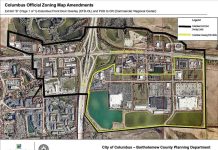City and county officials are preparing to consider an application to install solar panels on nearly 2,000 acres in southeast Bartholomew County
Carina Solar, LLC, a subsidiary of Samsung C&T, has submitted an application for a conditional use permit to construct, operate and maintain a proposed 100 megawatt AC power generation facility. It will be placed on scattered agricultural property leased to the company by local property owners.
A nonprofit group, Bartholomew County Citizens Concerned about Commercial Solar Fields (B4CSF) has distributed literature and posted on social media that the Bartholomew County Board of Zoning Appeals (BZA) will consider the matter on Monday, Feb. 26., while the Columbus Board of Zoning Appeals will do the same the next evening on Tuesday, Feb. 27. B4CSF states both meetings will be held inside the first floor Cal Brand meeting room at Columbus City Hall.
However, those dates should be considered tentative at this time, city-county planner Jeff Bergman said. Carina Solar, LLC has been asked by members of Bergman’s staff to make corrections on its application no later than Feb. 12. If the company does not submit those changes by the deadline, Bergman said their appearance before the two BZA boards will be postponed.
Even if the deadline is met by the company, Bergman says the 5:30 p.m. start time for both meetings posted by B4CSF “is probably incorrect.” His department expects to make a formal announcement regarding the two BZA meetings sometime next week, Bergman said.
As proposed, the project will be placed on 48 parcels of scattered cultivated agricultural fields owned by 24 landowners. There are 1,605 acres leased to the company within Columbus Township, approximately 242 acres in Sand Creek Township, and 98 acres in Rock Creek Township.
This covers a wide area generally located north of County Road 400S, west of County Road 525E, east of South Gladstone Avenue and south of County Road 100S. As designed, the solar panels will deliver power to the electrical grid through one point of interconnection at a proposed substation and switchyard location.
If the application is approved and a conditional use permit is secured, construction of the project is scheduled to commence as early as the second quarter of next year.
Although the Columbus City Council did approve a number of restrictions last fall regarding solar power plants, Carina Solar, LLC submitted its application before those new restrictions were adopted, assistant city/county planning director Melissa Begley said. That means the company can apply to the Columbus BZA for a conditional use approval within the city’s two mile jurisdiction, Begley said.
The city and county BZA utilize a specific four-point criteria of development standards when making decisions on requests for conditional use approvals.
- The project will not be injurious to the public health, safety and general welfare of the community.
- The development will be consistent with the intent of the development standards established by the Zoning Ordinance for similar uses.
- The conditional use will not be contrary to the general purposes service by the Zoning Ordinance, and will not permanently injure other property or uses in the same zoning district and vicinity.
- The condition use will be consistent with the character of the zoning district in which it is located and the recommendations of the comprehensive plan.
While Carina Solar, LLC claim in their conditional uses permit application they meet those standards, local BZA officials will listen to public testimony and make their own determinations before making their decisions.
B4CSF members say they have seen multiple studies that show home value losses up to a half-mile away from large-scale solar farms. While that claim was backed up last year in a study by Lawrence Berkeley National Laboratory, the results also shows resale prices are, on average, only 1.5% less than houses just a little farther away from solar farms.
Other top concerns expressed by B4CSF include mass fields of solar panels that they consider unsightly, as well as the displacement of up to five local tenant farmers.





